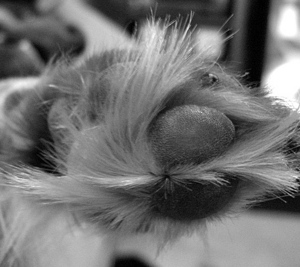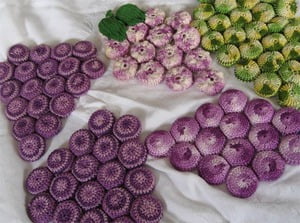A dog’s paw pad is prone to injury, and paw pad and foot injuries can be difficult to heal, but follow these tips and and injured dog will be well on his way to recovery.
Competitive Musher Edward Long is no stranger to paw pad wounds, as his dog sled team is frequently getting cuts, scrapes and other wounds from their treks across the snow and ice. Long offered these tips for pet owners who have a dog with an injured foot:
– Begin by trimming the fur on the bottom of the foot between the pads to help allow for better visibility of the wound site and better air flow to the region.
– The next step entails cleaning and removing any debris from the paw pad. Soak the dog’s foot in warm water for 15 minutes. Add Epsom salts to help soften the skin, cleanse the dog’s injured paw, and rinse away bacteria and debris.
– Swish the dog’s foot through the water to painlessly dislodge debris.
– After the dog’s foot soaks for 15 minutes, use an anti-bacterial soap like Dial to wash the dog’s paw pad. Thoroughly wash and rinse the foot.
– Use paper towels to pat the foot dry. Avoid using towels, as they will transfer bacteria to the dog’s wounded foot.
– The dog’s paw should be examined for any embedded debris, like glass. Use tweezers to gently remove any debris, or visit your vet for further assistance.
– Disinfect the paw pad injury with Betadine. Pour the Betadine directly onto the wound or use a sterile gauze pad to dab generous amounts of betadine onto the injury site.
– Allow the Betadine to air dry and do not directly contact the disinfected area after this step, to minimize the chance of contamination which can ultimately lead to infection.
– Apply a dab of antibiotic ointment onto the wound to help promote healing.
– Bandage the foot using rolled gauze. Bandaging is not common practice for pets as it allows for the growth of anaerobic bacteria in the air-free environment, but the foot is the exception since it’s exposed to all bacteria and dirt. Wrap the gauze around the foot and ankle in a “figure 8.” The bandage should be firm, but not tight, as this can lead to interruptions in circulation. Feel the toes after bandaging, as if the bandage is too tight, the toes will become cool and the dog will be more apt to bite at the bandage.
– Cover the gauze with a self-adhering Ace Bandage, using the same wrapping technique. This will make for a more durable bandage that’s suitable for walking.
– In addition, when the dog goes outside, cover the bandaged paw with a plastic bag or sock, with the bag or sock secured around the ankle with tape. This will keep the bandage clean and free of debris.
Wash, disinfect, dress and wrap the dog’s foot wound twice daily until healed.
If the dog bites or otherwise disturbs the bandage, owners can purchase an Elizabethan Collar (also known as an “e-collar” or “lampshade collar”) from their veterinarian’s office or from major pet supply stores like Petco.
If any signs of infection are noted, like increased redness, swelling or discharge, a visit to the veterinarian’s office will be required for an examination and possibly a prescription of antibiotics. Also, if the wound is larger than half-an-inch in diameter, then specialized care may be required to help promote proper healing.




